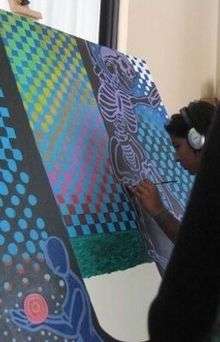Olivia Kapoor
Olivia Kapoor is best known as one of the pioneering Visionary Artists within the Inter-Dimensional Art Movement. She is an American painter who has exhibited and showcased her work in Paris,[1] London,[2] Amsterdam, New York City, Los Angeles, Miami, Toronto, and Bologna.

Following the teachings of noted 19th and early 20th century faculty from The Bauhaus Modernist Art School, Kapoor continues to examine Wassily Kandinsky’s, Josef Albers’, Laszlo Moholy-Nagy’s, Paul Klee’s, and Johannes Itten’s exploration of the relationship of art, technology, and the universe.
Utilizing music as a method to evoke the inner senses, Kapoor follows the masters of the Bauhaus School,[3] known for their exploration of the effect of music on the artist, and the relationship between rhythm and movement in art.[4]
Inspired by revolutionary artists, Dali, Van Gogh, Monet, and Johannes Vermeer, Kapoor’s paintings combine geometric forms with undulating images of human figures, animals, and plants, bridging motifs as well as temporal and spatial boundaries.
Kapoor works in acrylics, pastels, and charcoal, giving her images a textural variety that underlines the effects of her motion-filled compositions—that feeling of movement is further heightened by her vibrant color palette. These factors are combined with her strong sense of line, in which even the most meandering stroke is executed with firm control. Her art is innovative and is considered “an open-ended body of work, that is made all the more effective, through its mathematical precision.[5]”
Exploring the boundaries of the broader constructs of time, Kapoor describes her paintings as “futuristic, with many depths and layers of bright colors, varied textures, and rigorous geometric patterning.[6]”
Each work, although unique and unto their own, are true abstracts that convey the rhythm of color through repetition and stroke. Kapoor’s style, encompasses the relationship between music, rhythm, and art, and she frequently utilizes music to achieve and express synesthesia.
International Exhibitions
In 2009, at age 23, Olivia was the National Winner of the American Red Cross Measles Vaccination Art Competition. Since then, her artwork has been featured all over the world with exclusive exhibitions and showcases in:
In New York City’s famous Chelsea Art District, Kapoor’s art can be found at the Agora Gallery,[7] founded by Miki Stiles in 1984 and currently directed by Angela Di Bello. Di Bello is known for her expertise in the art arena and her critique of Lady Gaga’s art debut.[8]
At the International Art Fair of Contemporary Art in Amsterdam,[9] Kapoor worked with artists such as Emma Lindstrom, Ellen Stapleton,[10] Lauren Jay Wondra,[11] Jan Van-Well, and Barry Boem. Using methods such as Impasto, many of these artists represent the Inter-dimensional Art Movement, and the quest to use art as a tool for personal and spiritual evolution.
Early career
Although Kapoor received her associate degree in Art from Paradise Valley Community College in the Spring of 2010, she first studied Art through the undergraduate program of Lake Forest College, from 2005 to 2006. While there, she studied under professors such as Rebecca Goldberg, and Eli Robb. Oftentimes, many people ask Kapoor where she derives the bulk of her creative process from, including the fact that she has not formally been taught painting within her field of study.
In her early work, Kapoor created art through meditative experiences guided with the use of Psilocybin's and music. Parallel to the experience of other Inter-dimensional and Visionary Artists, such as Alex Grey, who have used Entheogens to create art, Kapoor’s experience transformed her ability to explore the depths of consciousness by challenging traditional concepts of time, existence, and philosophy.
She explains, “My state of mind and how I felt emotionally, greatly contributed to my visual expressionism on canvas. These emotions ranged from joy and hope, to deep contemplativeness, which yielded highly surrealistic and symbolic manifestations.”
Entheogens have been documented by studies such as Timothy Leary's Marsh Chapel Experiment and Roland Griffiths' psilocybin studies at Johns Hopkins[12] to result in mystical experiences that have enhanced higher order thinking and consciousness.
Current Work
Categorized as dreamlike, and the epitome of pure visual expressionism, she largely uses acrylics, ink, and crayon to convey the most mathematically pleasing relationship between color ratios, and their conjunction to the rest of the canvas.
Olivia explains, “I enjoy using vivid colors to fill each canvas with the transposing of both negative and positive spaces.”
Her work is best known for its fields of bright colors, textures, and patterns, placed alongside other freely drawn images with spatial boundaries.
Transcendent in its ability to express personal, spiritual, and universal growth, Olivia Kapoor’s art contributes to the movement of Inter-Dimensional Visionary Artists' who are using art to express continuous connections between the universe, existence, and art.
References
- ↑ "Olivia Kapoor". Art Galleries Europe. Retrieved 2016-09-13.
- ↑ "London Exhibition". Art Galleries Europe. Retrieved 2016-09-13.
- ↑ Winton, Author: Alexandra Griffith. "The Bauhaus, 1919–1933 | Essay | Heilbrunn Timeline of Art History | The Metropolitan Museum of Art". The Met’s Heilbrunn Timeline of Art History. Retrieved 2016-09-13.
- ↑ L., Kennedy, Sharon (2007-01-01). "Painting Music: Rhythm And Movement In Art".
- ↑ "Agora Gallery - Olivia Kapoor - Exhibition Invitation". www.agora-gallery.com. Retrieved 2016-09-13.
- ↑ "ARTisSpectrum Magazine". ARTisSpectrum.com. Retrieved 2016-09-13.
- ↑ "Agora Gallery - Contemporary Fine Art". www.agora-gallery.com. Retrieved 2016-09-13.
- ↑ Schuster, Dana (2013-09-08). "Lady Gaga's new look". New York Post. Retrieved 2016-09-13.
- ↑ "Amsterdam International Art Fair". www.iamsterdam.com. Retrieved 2016-09-13.
- ↑ "Ellen Stapleton - MURALS". Ellen Stapleton. Retrieved 2016-09-13.
- ↑ "Lauren Wondra | Saatchi Art". Retrieved 2016-09-13.
- ↑ MacLean, Katherine A.; Johnson, Matthew W.; Griffiths, Roland R. (2011-11-01). "Mystical Experiences Occasioned by the Hallucinogen Psilocybin Lead to Increases in the Personality Domain of Openness". Journal of psychopharmacology (Oxford, England). 25 (11): 1453–1461. doi:10.1177/0269881111420188. ISSN 0269-8811. PMC 3537171
 . PMID 21956378.
. PMID 21956378.